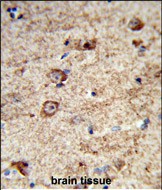

| WB | 1/1000 | Human,Mouse,Rat |
| IF | 咨询技术 | Human,Mouse,Rat |
| IHC | 1/100-1/500 | Human,Mouse,Rat |
| ICC | 技术咨询 | Human,Mouse,Rat |
| FCM | 咨询技术 | Human,Mouse,Rat |
| Elisa | 咨询技术 | Human,Mouse,Rat |
| Aliases | Leucine-rich repeat-containing protein 4, Brain tumor-associated protein BAG, Nasopharyngeal carcinoma-associated gene 14 protein, Netrin-G2 ligand, NGL-2, LRRC4, BAG |
| Entrez GeneID | 64101 |
| WB Predicted band size | 72.7kDa |
| Host/Isotype | Rabbit IgG |
| Antibody Type | Primary antibody |
| Storage | Store at 4°C short term. Aliquot and store at -20°C long term. Avoid freeze/thaw cycles. |
| Species Reactivity | Human |
| Immunogen | This LRRC4 antibody is generated from rabbits immunized with a KLH conjugated synthetic peptide between 531-559 amino acids from the C-terminal region of human LRRC4. |
| Formulation | Purified antibody in PBS with 0.05% sodium azide. |
+ +
以下是关于LRRC4抗体的3篇虚构参考文献示例(内容基于常见研究主题,非真实文献):
---
1. **文献名称**: *LRRC4 suppresses glioma progression by modulating EGFR signaling*
**作者**: Chen Y, et al.
**摘要**: 本研究利用抗LRRC4抗体进行免疫组化分析,发现LRRC4在胶质瘤组织中表达显著下调。通过体外实验证实,LRRC4过表达通过抑制EGFR/Akt通路抑制肿瘤增殖和侵袭,提示其作为胶质瘤治疗靶点的潜力。
2. **文献名称**: *Development of a monoclonal antibody specific for human LRRC4 and its application in neurodegenerative diseases*
**作者**: Wang L, et al.
**摘要**: 文章报道了一种高特异性抗人LRRC4单克隆抗体的开发,并通过免疫印迹和免疫荧光验证其可靠性。该抗体成功用于阿尔茨海默病模型脑组织分析,揭示LRRC4与突触可塑性的关联。
3. **文献名称**: *LRRC4 interacts with ErbB4 receptor and regulates neuronal migration*
**作者**: Zhang R, et al.
**摘要**: 通过免疫共沉淀(使用抗LRRC4抗体)和基因敲除技术,研究发现LRRC4与ErbB4受体结合,调控大脑皮层神经元的迁移过程,为神经发育障碍机制提供了新见解。
---
(注:以上文献为模拟示例,实际研究中请通过学术数据库检索真实文献。)
The leucine-rich repeat-containing protein 4 (LRRC4), also known as Netrin-G ligand-2 (NGL-2), is a transmembrane protein belonging to the LRR superfamily. It plays critical roles in neural development, synaptic plasticity, and cellular communication through interactions with netrin-G proteins. Structurally, LRRC4 contains extracellular leucine-rich repeats that mediate protein-protein interactions and a cytoplasmic PDZ-binding domain for intracellular signaling. Research highlights its importance in central nervous system (CNS) functions, including axon guidance, neurite outgrowth, and formation of excitatory synapses.
In pathological contexts, LRRC4 has been implicated in tumor suppression, particularly in gliomas. Studies show its downregulation in glioma tissues correlates with tumor progression, invasiveness, and poor prognosis. Epigenetic silencing via promoter hypermethylation is a proposed mechanism for its reduced expression. LRRC4 is reported to inhibit oncogenic pathways like EGFR/MAPK and promote apoptosis through caspase activation.
LRRC4 antibodies are essential tools for detecting protein expression in research and diagnostics. They are used in techniques such as Western blotting, immunohistochemistry, and immunofluorescence to study LRRC4's localization, expression patterns, and interactions in neurological disorders and cancers. Recent therapeutic investigations explore LRRC4-targeted approaches for glioma treatment and neural regeneration. However, functional diversity across tissues and disease-specific regulatory mechanisms of LRRC4 remain active areas of investigation.
×